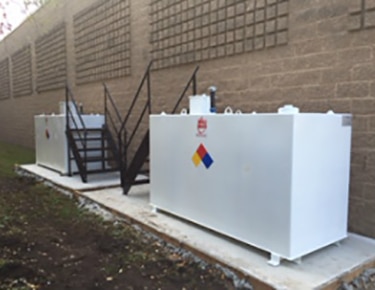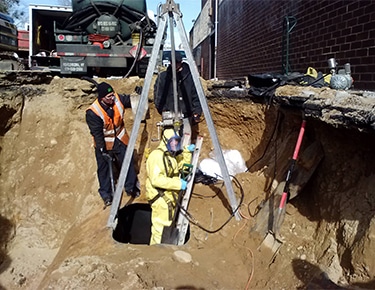Tank services we provide
Above Ground and Underground Storage Tank Management, Compliance, Removal, Spill Closure & Documentation
Oil Tank Installations (Above and Below Ground)
Tank Removals
(Oil, Gasoline, Propane, Diesel, Above & Below Ground)
Underground Tank Abandonments
(Foam, Sand and Concrete Slurry)
Above Ground and Underground Storage Tank Management, Compliance, Removal, Spill Closure & Documentation
Above ground and underground storage tank (AST and UST) management, compliance, removal, spill closure, and documentation are essential aspects of environmental regulation and risk management associated with the storage of hazardous substances, petroleum products, or other potentially harmful materials. Here’s an overview of each component:
- Management: AST and UST management involves the proper handling, storage, and maintenance of storage tank systems to prevent leaks, spills, or releases of hazardous substances into the environment. This includes regular inspections, testing, and maintenance of tanks, as well as implementing measures to minimize the risk of corrosion, overfilling, or other potential sources of failure.
- Compliance: Compliance with regulatory requirements is critical for AST and UST operators to ensure the safe and legal operation of storage tank systems. Depending on the jurisdiction, regulations may be established at the federal, state/provincial, or local level and may include requirements for tank design, installation, operation, maintenance, testing, and reporting. Common regulations include the Resource Conservation and Recovery Act (RCRA) in the United States and similar regulations in other countries.
- Removal: AST and UST removal may be necessary when tanks are no longer in use, obsolete, or at the end of their service life. Removal involves decommissioning the tank, safely emptying and cleaning it, and either properly disposing of or recycling the tank and associated equipment. Removal must be conducted in accordance with regulatory requirements to minimize environmental impacts and ensure worker safety.
- Spill Closure & Documentation: In the event of a spill or release from an AST or UST, spill closure and documentation procedures are followed to assess and remediate the environmental impacts, document the response actions taken, and ensure regulatory compliance. This may involve containment and cleanup of spilled materials, notification of regulatory authorities and other stakeholders, and documentation of spill response activities, including sampling and monitoring results, cleanup efforts, and any follow-up actions taken to prevent recurrence.
- Closure Documentation: Closure documentation involves compiling all necessary records, reports, and documentation to demonstrate that an AST or UST has been properly closed and decommissioned in accordance with regulatory requirements. This may include documentation of tank removal, closure assessment reports, site assessments, monitoring data, and regulatory notifications or approvals. Closure documentation is typically submitted to regulatory agencies for review and approval before the tank site can be considered officially closed and removed from active oversight.
Overall, effective AST and UST management, compliance, removal, spill closure, and documentation are essential for protecting human health and the environment, preventing pollution, and ensuring the safe and responsible operation of storage tank systems.
Oil Tank Installations (Above and Below Ground)
Above Ground & Basement
Windmill can install above ground indoor and outdoor oil, diesel and gasoline tanks. Windmill offers tanks which vary in shape, size and configuration. Our most popular above ground tanks include the widely used Granby 275 gallon and 330 gallon. These tanks can be used either indoors or outdoors. We are a platinum awarded Granby installation contractor.
Residential double-wall oil tanks manufactured by Roth are also available. Double-wall construction provides 110% capacity of the inner tank for maximum protection. These vertical tanks are a great way to save space in a basement or are easily concealed outdoors. They can be used for heating oil, diesel and bio-fuels.
Underground Tank Installation For Residential Use
For residential buried tank installation, depending on the county, we offer a variety of state-of-the-art buried tanks. Single-wall or double-wall fiberglass tanks, steel cathodically protected tanks (STPI), fiberglass wrapped steel tanks, and ACT-100 epoxy-coated tanks are available.
Above & Underground Tanks For Commercial Use
Windmill’s commercial installation crew has extensive experience installing fuel oil, gasoline, diesel and waste oil tanks with above and below ground applications. For commercial use, Windmill will review or engineer plans in compliance with County and State regulations.
1,000 gallon above ground tanks for commercial use are a great alternatives for large buildings with separate boilers for convenient and efficient multi-tank systems.
Warranties & Insurance
Depending on the model, our oil tanks come with a 10-30 year warranty. Our most popular tanks, the Granby 275 gallon and the Granby 330 gallon come with 10-30 year warranties. The Roth double-wall comes with a 30 year warranty. The ACT-100 epoxy-coated underground tanks come with a 30-year guarantee.
All tanks installed by Windmill come with pollution liability insurance from the tank manufacturer (up to two million dollars per occurrence.) With new tank installations, oil can be stored in a safe, clean, and reliable manner with out worry.



Tank Removals (Oil, Gasoline, Propane, Diesel, Above & Below Ground)
Above Ground & Basement Tank Removal
Above ground and basement tank removal refers to the process of decommissioning and removing storage tanks located either above ground or in basements of buildings. These tanks are commonly used for storing heating oil, diesel, gasoline, or other petroleum products for residential, commercial, or industrial purposes. Above ground or basement tanks which are no longer in use can be pumped clean of any residual oil and picked up by our crew. The whole process takes less than an hour. It’s as simple as that.
Underground Tank Removal
Windmill has the ability to remove any size tank. The process for removing an abandoned buried tank is similar to that of installing a buried tank. The tank is excavated, leaving some extra room on all sides to make removal easier. The tank is then cut open and pumped out with a vacuum truck. A crew of highly trained tank technicians then enter the tank, and clean the walls and bottom to prevent any remaining oil from spilling out during the removal process. Finally, the tank is removed from its grave and disposed at a licensed facility. The excavation is then filled in with clean fill. If the ground should sink or settle in the future (which is unlikely because our adept crew makes every effort to pack and level the soil at the time of excavation), we will return to add more fill if needed.



Underground Tank Abandonments (Foam, Sand and Concrete Slurry)
Tank abandonment refers to the process of permanently taking a storage tank out of service by rendering it inert, empty, and incapable of storing or transporting hazardous substances or materials. Tank abandonment is typically done when a tank is no longer needed, has reached the end of its service life, or poses risks due to deterioration, damage, or obsolescence. Windmill Oil Tank Service offers the following methods of tank abandonment.
Tank Abandonment with Foam
In Nassau and In Nassau and Suffolk counties, most tanks less than 1,100 gallons can be abandoned with foam (depending on the water table). In New York City, any size tank can be abandoned with foam. Prior to the abandonment, an approved waste oil truck with vacuum capabilities will remove any oil, water or sludge remaining inside the tank. Once the tank is vacuum cleaned, Speedy Dry is used to absorb any residual oil. Then, the underground oil tank is completely filled with approved foam. Lastly, the fill and vent pipes are removed and the openings are filled with cement to render the tank completely unusable. Upon completion of the work, a certificate of abandonment will be issued.
Tank Abandonment with Sand
Sand abandonments are necessary in areas where there is a high water table. In order to sand abandon an underground oil tank, first the top of the tank is excavated and cut open. Then all remaining contents are removed using a truck with vacuum enhanced capabilities. Then, a confined space entry team enters the tank to completely clean the tank bottom and inner side walls. The final phase is for the technicians to completely fill the tank with sand. Once the tank is filled, the technician closes the tank, backfills the excavation and removes all piping associated with the underground oil tank. The holes for the fill and vent pipe are cemented shut and upon completion of the work, a certificate of abandonment will be issued.
Tank Abandonment with Concrete Slurry Mix
Slurry, or abandonment using cement, is necessary for tanks over 1,100 gallons that must remain in place due to engineering constraints. The process is the same as that of a sand abandonment, except that cement is pumped into the tank instead of sand. Slurry is not usually necessary for residential tanks. In the event that a slurry abandonment is required, Windmill will contact the proper government agencies on your behalf to obtain written permission prior to commencement of the work. Upon completion of the work, a certificate of abandonment will be issued.
